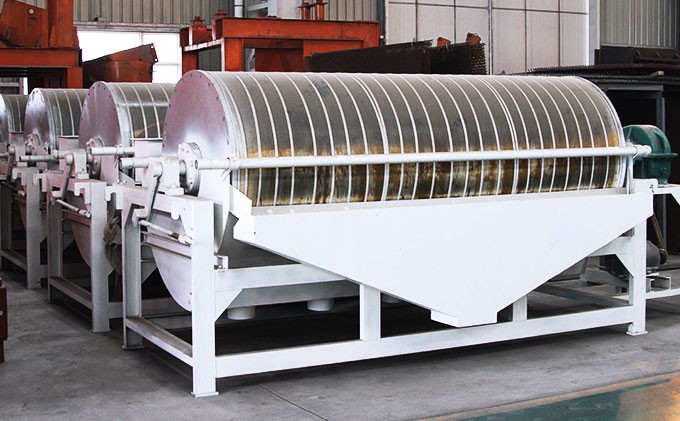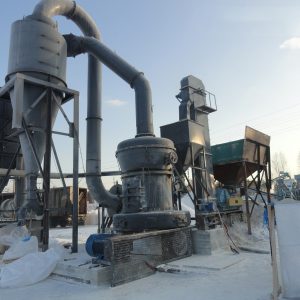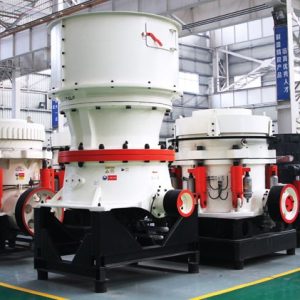What is a magnetic drum separator?
In mineral processing, a magnetic drum separator, also known as a drum magnet, separates non-magnetic material from magnetic material based on their magnetic differences.
Common applications include iron ore beneficiation, industrial minerals processing, coal processing, and beach sand beneficiation. Let’s examine each of these:
Iron ore: In iron ore beneficiation, the magnetic particles like magnetite or hematite are attracted to the drum and carried along with it. Meanwhile, non-magnetic particles continue on their path and are discharged separately.
Industrial minerals: Magnetic separators remove magnetic impurities from industrial minerals such as feldspar, quartz, and mica to enhance the purity and quality of the minerals for industrial use.
Coal processing: Magnetic separators eliminate magnetic impurities from coal to improve its purity and quality.
Sand beneficiation: Magnetic separators collect magnetic minerals like ilmenite, rutile, zirconium, and garnet in heavy mineral sands as a concentrated form.
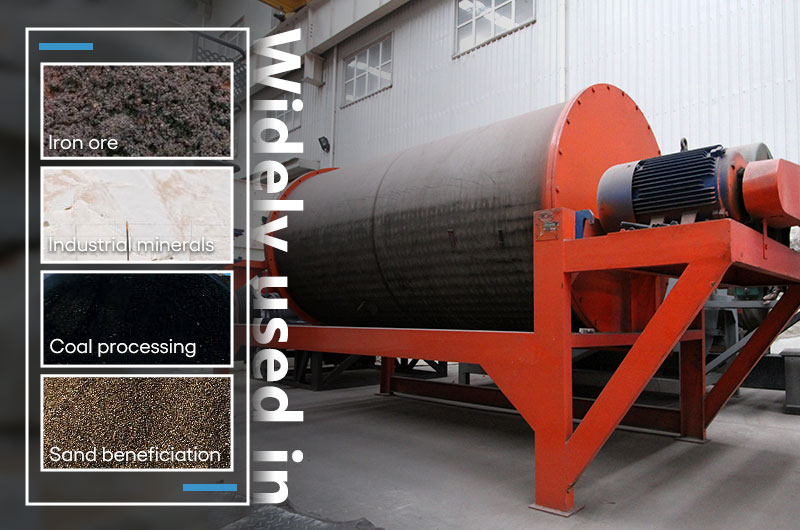
What is a magnetic drum separator?
In mineral processing, a magnetic drum separator, also known as a drum magnet, separates non-magnetic material from magnetic material by utilizing magnetic differences.
Reliable manufacturer of magnetic drum separators
GUOGAO Machinery is dedicated to providing customers with reliable and efficient magnetic separation equipment while fully understanding customer needs. Factors to consider when customizing equipment for customers include:
Drum size and configuration: Customize the magnetic drum separators according to specific processing requirements, including options for single or multiple separators, as well as the diameter and length of the drums.
Magnetic field strength: Determine the optimal magnetic field strength based on material characteristics and separation objectives in order to achieve maximum separation efficiency.
Material and construction: Select appropriate structural materials for the separator’s components such as the drum surface, outer shell, and internal parts. Consider factors like mineral abrasiveness and corrosion resistance to ensure durability and extended service life.
Adjustable parameters: Fine-tune the separation process by adjusting parameters such as drum speed, magnetic field strength, or inclination. This allows operators to optimize separation performance for specific material properties.
Automatic cleaning mechanisms: Configure automatic scraper systems, self-cleaning belts, or air blowing systems that can complete the cleaning process of the drum surface without manual intervention.
Power requirements: Power requirements for magnetic drum separators vary depending on factors such as size, magnetic field strength, drum speed design features. Additionally consider available voltage levels,currents,and frequencies at installation sites.
Why choose Guogao Machinery magnetic drum separators?
Our permanent magnetic system utilizes high-quality ferrite or a composite material that includes ferrite and rare earth magnetic steel. The average magnetic induction intensity on the drum surface ranges from 100 to 600mt. Over an 8-year period, the demagnetization rate of the magnetic density is no more than 5%.
The large wrap angle magnetic system with gradual field strength and smooth transition extends the length of the separation zone and increases the number of magnetic flips, resulting in efficient separation.
By covering the magnetic system with non-magnetic stainless steel, we ensure that there is no peeling off of the magnet.
Our permanent magnets have strong adaptability for production, allowing them to withstand significant changes in feeding amount, particle size, and pulp concentration.
We can achieve good processing indexes such as high grade and high recovery rate simultaneously.
All series of our magnetic separators can be used cooperatively or individually to obtain excellent processing indexes.
Types of magnetic drum separators
Magnetic drum separators are divided into dry magnetic drum separators and wet magnetic drum separators.
Dry magnetic drum separators
A dry magnetic drum separator, as the name suggests, operates without the use of water or a liquid medium.
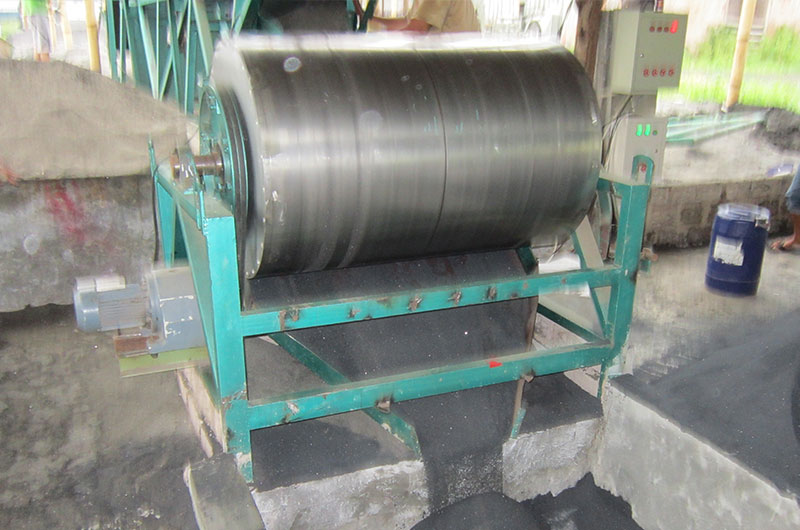
The dry feed, with a particle size less than 3mm, is fed onto the rotating drum. Magnetic particles adhere to the surface of the drum, while non-magnetic particles fall off due to gravity or other forces. The separated magnetic particles are carried to a discharge point and released or brushed off.
Dry magnetic drum separators use magnetic field strength, gradient, gravity, and other forces to separate and transport particles without water or a liquid medium.
A model of dry magnetic drum separator includes a rare earth roll (RE Roll), which is a high-intensity magnet capable of separating strong and weak magnetic materials from non-magnetic material in a dry state.
Advantages of dry magnetic drum separators:
1. No water requirement: Dry magnetic drum separators operate without the need for water, making them convenient and cost-effective. They are particularly advantageous in situations with limited water availability or when focusing on water conservation.
2. Versatility: By adjusting parameters such as magnetic field strength and drum speed, dry magnetic drum separators can process various minerals including iron ore, chromite, garnet, tantalite, and other magnetic minerals.
3. Easy maintenance: Dry magnetic drum separators generally have simpler designs with fewer components compared to wet separators. This results in easier maintenance and lower maintenance costs.
Wet magnetic drum separators
A wet magnetic drum separator operates in the presence of water or a liquid medium.
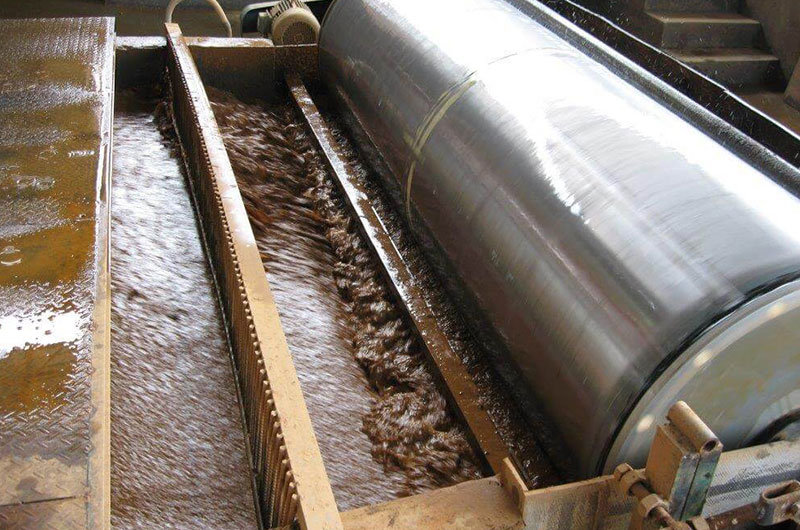
The feed material is mixed with water and fed onto the rotating drum. Magnetic particles adhere to the drum’s surface as it rotates, while non-magnetic particles are separated by gravity or other forces. Eventually, the magnetic particles are released or flushed off at the discharge point.
The presence of water or liquid medium in the wet magnetic drum separator facilitates the movement and separation of magnetic and non-magnetic particles. It also helps transport the separated magnetic particles to the discharge point.
The permanent magnetic drum wet separator is suitable for ores such as magnetic pyrite, roasted ore, ilmenite, and other materials with a particle size less than 3mm.
Types of wet magnetic drum separators:
It can be categorized into three types based on different tanks:
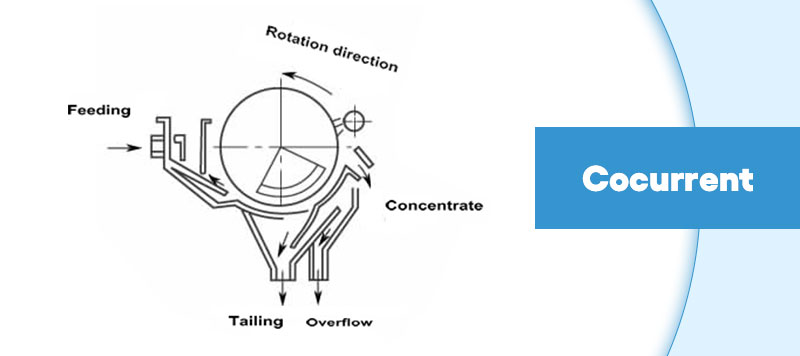
Cocurrent: The slurry feed flows in the same direction as the rotating drum. The magnetic concentrate is discharged through the concentrate launder, while the tailings are released directly from the bottom.
This method is perfect for coarse selection of strong magnetic minerals (0-6mm), providing a high recovery rate and grade.
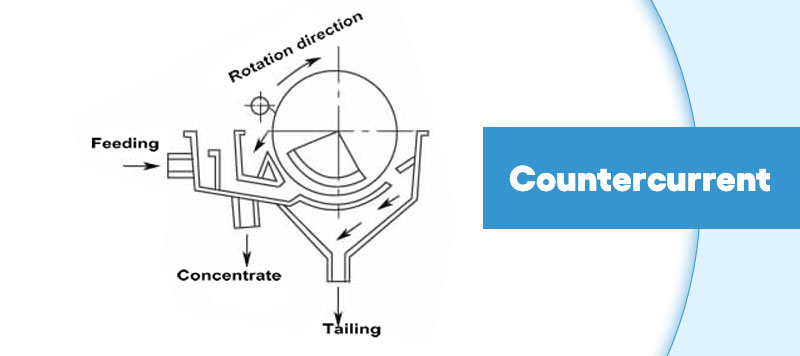
Semi-countercurrent operation involves the slurry feed moving partially in the same direction as, and partially opposite to, the rotation of the drum. This promotes thorough washing and prevents inclusions by circulating the slurry within the tank. Additionally, this method facilitates recycling as the slurry moves according to magnetic force.
The advantages of wet magnetic drum separators are:
1. The full magnetic design allows for a large contact area between the pulp and effective working surface.
2. They significantly reduce the magnetic content of tailings, with levels 1-3% lower than ordinary magnetic separation equipment.
3. The separating process is extended, resulting in a 2-4% increase in concentrate grade.
4. They can handle varying slurry densities, feed rates, and particle sizes without compromising separation performance. This makes them suitable for operations with fluctuating feed characteristics.
5. They can be easily integrated into existing mineral processing circuits such as grinding and classification circuits to enhance overall efficiency of mineral processing operations.
The main components of a permanent magnetic drum separator are a permanent magnet system, a rotating drum, a separating chute, a feed tank, and a flushing pipe. Guogao Machinery is dedicated to delivering high-quality permanent magnetic drum separators to customers.
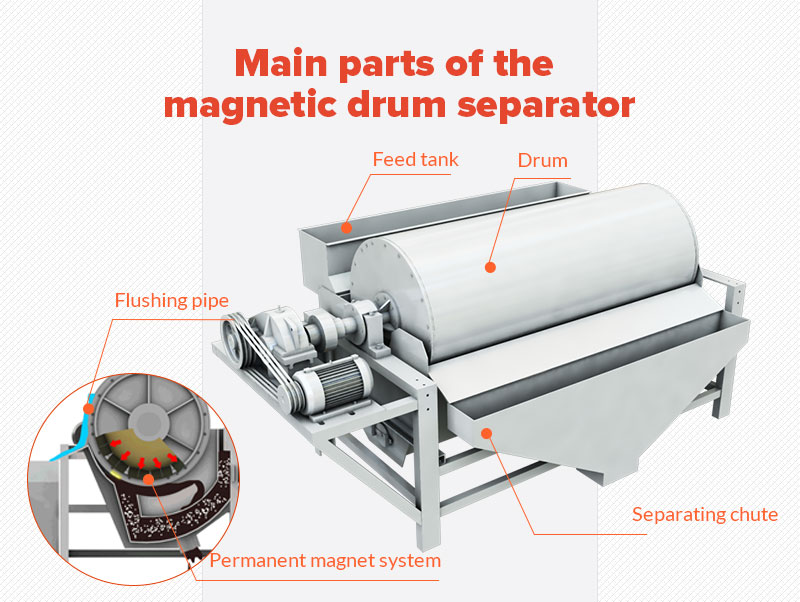
Parameter
| Model | Shell diameter (mm) |
Shell lenght (mm) |
Shell rotation speed(r/min) |
Feeding size (mm) |
Processing capacoty (t/h) |
Power(kw) |
| CTB6012 | 600 | 1200 | <35 | 2-0 | 10-20 | 1.5 |
| CTB6018 | 600 | 1800 | <35 | 2-0 | 15-30 | 2.2 |
| CTB7518 | 750 | 1800 | <35 | 2-0 | 20-45 | 2.2 |
| CTB9018 | 900 | 1800 | <35 | 3-0 | 40-60 | 3 |
| CTB9021 | 900 | 2100 | <35 | 3-0 | 45-60 | 3 |
| CTB9024 | 900 | 2400 | <28 | 3-0 | 45-70 | 4 |
| CTB1018 | 1050 | 1800 | <20 | 3-0 | 50-75 | 5.5 |
| CTB1021 | 1050 | 2100 | <20 | 3-0 | 50-100 | 5.5 |
| CTB1024 | 1050 | 2400 | <20 | 3-0 | 60-120 | 5.5 |
| CTB1218 | 1200 | 1800 | <18 | 3-0 | 80-140 | 5.5 |
| CTB1224 | 1200 | 2400 | <18 | 3-0 | 85-180 | 7.5 |
| CTB1230 | 1200 | 3000 | <18 | 3-0 | 100-180 | 7.5 |
| CTB1530 | 1500 | 3000 | <14 | 3-0 | 170-280 | 11 |

